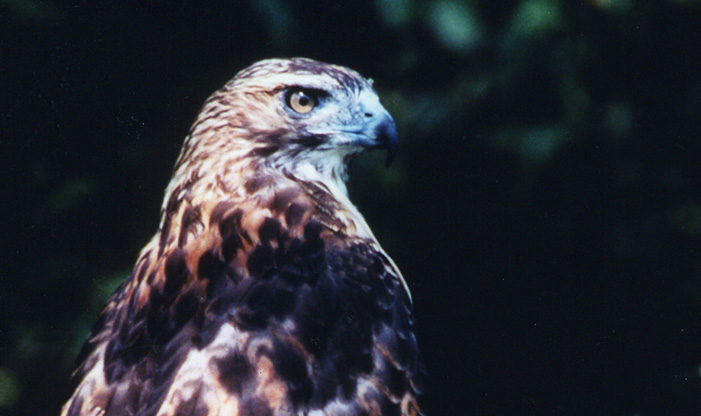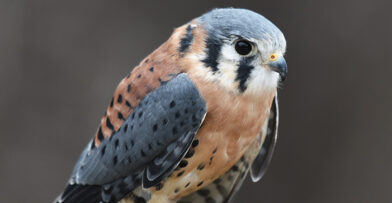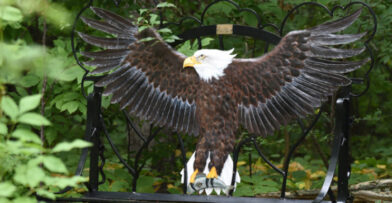Our Raptor Program spreads environmental awareness and inspires appreciation for wildlife through our raptor ambassadors. From our humble beginnings, the program has grown into a regionally renowned educational resource about raptors and conservation.
The Beginning of our Raptor Program
In the 1970s, Wildlife Arc, a wildlife rehabilitation organization, was located on our property. When it was decided that the Arc would move to the Humane Society, the Center applied for state and federal permits to possess native, migratory birds that serve as animal ambassadors. Wildlife Arc donated a Great Horned Owl and two Eastern Screech Owls to the Center. With the acquisition of our US Fish and Wildlife Service & Wisconsin DNR permits, and these few birds, the Raptor Program as we know it today began. Every one of our resident birds is not releasable to the wild and is in our permanent care.
In 1992, the Center had the opportunity to add a Red-tailed Hawk to our collection. RT, as she came to be known, increased our collection size and the program’s ability to provide some the most unique environmental experiences in the Milwaukee area.
Building our New Raptor Facility
By the mid-90’s, our raptor housing was no longer adequate to meet state and federal standards. A new facility, funded by corporate sponsors as well as Schlitz Audubon volunteers and members, was built in 1998. The site for our new raptor care facility was chosen for its sunlight, air movement, good drainage, and access to water and electricity. This building gives our education birds a safe and secure place to live and relax when not educating. It also provides space for our staff and volunteers to feed, train, and provide enrichment for the birds.
The new facility was built with intention to add more birds to our program, and soon after we welcomed our first Bald Eagle. Quickly, a Peregrine Falcon, a Barn Owl, another Great Horned Owl, two American Kestrels, a Barred Owl, and another Red-tailed Hawk joined our feathered flock.
Our Public Programming
This meant we had a broad-based collection that allowed the Center to do both on and off-site raptor educational programming. Throughout the years, we have developed public programs that still take place today. Our annual festival, Xtreme Raptor Day, is in its 14th year. Another mainstay is Word with a Bird, weekend meet and greets with our birds. Raptor Saturday, an hour-long monthly program, has been supported by the We Energies Foundation since its beginning. Our Raptor Program has entertained and educated fairgoers at Wisconsin State Fair since 2006. Here, our birds participate in two daily presentations at Energy Park, thanks to the generosity of We Energies.
While our educational programs offer engaging opportunities for people to meet our birds, we also wanted a way for visitors to see a raptor more regularly. So in 2016 we added a Raptor Exhibit to the left of the walkway leading to our Visitor Center. Most days, Sky Walker, our Red-tailed Hawk, is there to greet them. A few years later, we added a wingspan display at the exhibit, allowing people to gauge their arm length against the wingspan of four raptors species: a Bald Eagle, a Red-tailed Hawk, a Peregrine Falcon, and a Screech Owl.
The Raptor Program has grown in birds, staff, and volunteers over the years. Today, we average 350 educational programs a year. Our birds interact with over 60,000 people not only at the Center, but also in schools, libraries, museums and outdoor festivals, offering many their first close and personal experience with raptors. Our birds travel to these programs in a customized van, complete with photos of our birds on the outside and equipped inside with security features ensuring the birds’ safety and welfare. Today, our premier collection of 14 birds emphasizes raptors: hawks, owls, eagles, and falcons, but also includes other birds of prey such as a Turkey Vulture and an American Crow.
We are considered a leader in raptor education in the state and the Great Lakes region, and we are proud and honored to share these magnificent birds with the public, inspiring appreciation for our wild world. Stay tuned to see what – and who – the future brings to our Raptor Program!
Photo of RT provided by raptor volunteers, Ken and Barb Wardius


